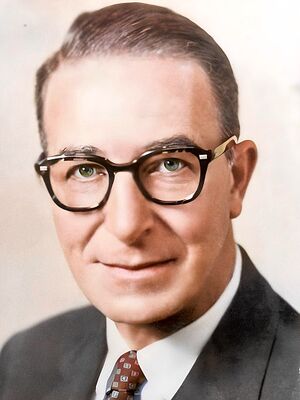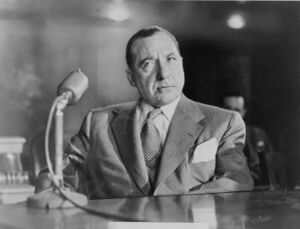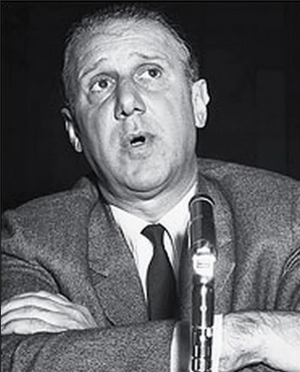Estes Kefauver
(politician) | ||||||||||
|---|---|---|---|---|---|---|---|---|---|---|
 | ||||||||||
| Born | Carey Estes Kefauver July 26, 1903 Madisonville, Tennessee | |||||||||
| Died | August 10, 1963 (Age 60) Bethesda, Maryland | |||||||||
Cause of death | heart attack | |||||||||
| Nationality | American | |||||||||
| Alma mater | University of Tennessee, Yale Law School | |||||||||
| Religion | Baptist | |||||||||
| Spouse | Nancy Kefauver | |||||||||
| Exposed | • the Mafia • the Outfit | |||||||||
| Interests | sexual blackmail | |||||||||
| Party | Democratic Party (United States) | |||||||||
US Senator who partially exposed organized crime - was at the same time blackmailed by the Chicago mob.
| ||||||||||
Carey Estes Kefauver[1] was an American politician from Tennessee. A member of the Democratic Party, he sat in the U.S. House of Representatives from 1939 to 1949 and in the Senate from 1949 until his death in 1963.
After leading a much-publicized investigation into organized crime in the early 1950s,he twice sought his party's nomination for President of the United States. In 1956, he was selected by the Democratic National Convention to be the running mate of presidential nominee Adlai Stevenson. He still held his U.S. Senate seat after the Stevenson–Kefauver ticket lost to the Eisenhower–Nixon ticket. Kefauver was named chair of the U.S. Senate Antitrust and Monopoly Subcommittee in 1957 and was its chairman until his death.
Contents
Kefauver Committee


On January 5, 1950, Senator Estes Kefauver introduced a resolution that would allow the Senate Committee on the Judiciary to investigate organized crime's role in interstate commerce.[2] Voting on the resolution extremely close. On May 3, 1950, Vice President Alben W. Barkley, sitting in his role as President of the United States Senate, cast the tie-breaking vote, and the Special Committee to Investigate Crime in Interstate Commerce was established.
The committee became popularly known as the Kefauver Committee because of its chairman. It sat from 1950 to 1951. The aim of the committee, which was formed from US senators, was to gather information about organized crime and to make proposals to combat it. Committee members traveled across the country in search of corruption and the conflation of politics and organized crime. The investigation caused quite a stir in the United States, compounded by the fact that this was the first Senate investigation to be televised.
The Kefauver Committee held hearings in 14 major cities across the United States.[3][4] More than 600 witnesses testified.[3][5] Many of the committee's hearings were televised live on national television to large audiences, providing many Americans with their first glimpse of organized crime's influence in the U.S.[6][4][7] Among the more notorious figures who appeared before the committee were Tony "Joe Batters" Accardo, Louis "Little New York" Campagna, Mickey Cohen, Willie Moretti, Frank Costello, Jake "Greasy Thumb" Guzik, Meyer Lansky, Paul "The Waiter" Ricca,[5][8] and Virginia Hill (former Joe Adonis-Chicago Outfit messenger and mobster Benjamin Siegel's girlfriend). A number of politicians also appeared before the committee and saw their careers ruined. Among them were former Governor Harold G. Hoffman of New Jersey and Mayor William O'Dwyer of New York City. Kefauver became a nationally recognized figure,[4] and the committee enabled him to run for President of the United States in 1952 and 1956 (his runs failed, but he became his party's vice presidential nominee in 1956).[9]
Sexual blackmail of Kefauver
After much advance publicity, the committee headed by Kefauver moved its investigation to Chicago. After a few days of secret meetings, however, Senator Kefauver and his staff suddenly departed without holding the public hearings that had been promised.
The Chicago Outfit and Sidney Korshak had succeeded in blackmailing Senator Kefauver, who was known to be a womanizer. In 1976, Seymour Hersh exposed in the New York Times that
“One trusted Korshak friend and business associate recalled in an interview that shortly after the committee's visit Mr. Korshak had shown him infrared photographs of Senator Kefauver in an obviously compromising position with a young woman. Mr. Korshak explained, the friend said, that a woman had been supplied by the Chicago underworld and a camera had been planted in the Senator's room at the Drake Hotel to photograph her with Mr. Kefauver. "Sid showed it to me," the friend said. "That was the end of hearings, and this also made Sid a very big man with the boys. Sid was the guy responsible."”
Seymour Hersh (1976) [10]
Kefauver also deposited $25,000 into his bank account on January 3, 1951, at the height of the committee hearings. The source of the funds was never learned. The timing of Kefauver's resignation in 1951 was also suspect. Just weeks before the chairman's departure, a Knoxville mobster and Kefauver campaign contributer named Herbert Brody was arrested.[11]
Big Pharma
Kefauver's Antitrust and Monopoly Subcommittee (1957-1963) also held hearings on the pharmaceutical industry between 1959 and 1963 that led to enactment of his most famous legislative achievement, the Kefauver-Harris Drug Act of 1962, after Kefauver expressed shock about the excess profits that U.S. drug companies were taking in at the expense of U.S. consumers.
After his death in 1963, it was learned that Kefauver owned over $300,00 in stock from the pharmaceutical companies that he had been charged with regulating in the Senate.[11]
Clint Murchison Jr.
In his autobiography, the Washington influence peddler Bobby Baker described how he delivered a briefcase stuffed with $25,000 in cash to a Kefauver aide in 1960. The money came originated from a group hoping to acquire an NFL franchise, but were opposed by Washington Redskins owner George Marshall After the money had changed hands, Kefauver's committee conveniently found that Marshall had been operating an illegal monopoly with his Washington Redskins Televison Network. That same year, the Dallas Cowboys franchise was awarded to a group headed by Texas oilman Clint Murchison Jr.[11]
Indecent publications
Kefauver also led hearings that targeted indecent publications and pornography. Among his targets were pin-ups, including Bettie Page, and the magazines that featured them.[12]
Related Quotation
| Page | Quote | Author | Date |
|---|---|---|---|
| US/Deep state | “During the 1940s and 1950s, corrupt politicians championed the politics of anti-communism in order to divert attention from the growing nexus between organized crime, big business and government. At the center of this nexus stood FBI Director J. Edgar Hoover (1924-1972), who cultivated mob connected businessmen in his war against communism, while refusing to cooperate with the Kefauver Committee's landmark investigation of organized crime in 1950-1951.” | Jeremy Kuzmarov | 10 June 2021 |
References
- ↑ "The Rise of Senator Legend". Time. March 24, 1952.
- ↑ https://www.archives.gov/legislative/guide/senate/chapter-18-1946-1968.html
- ↑ a b Thompson, Gambling in America: An Encyclopedia of History, Issues, and Society, 2001, p. 207.
- ↑ a b c Shanty, Organized Crime: From Trafficking to Terrorism, 2008, p. 22.
- ↑ a b Larson and Garrett, Crime, Justice and Society, 2003, p. 152.
- ↑ Friedman, The Secret Histories: Hidden Truths That Challenged the Past and Changed the World, 2005, p. 151.
- ↑ Hughes, Crime Wave: The Filmgoers' Guide to the Great Crime Movies, 2006, p. 147.
- ↑ Fontenay, Estes Kefauver: A Biography, 1991, p. 171.
- ↑ Kaiser, The Road to Dallas: The Assassination of John F. Kennedy, 2008, p. 12.
- ↑ https://www.nytimes.com/1976/06/27/archives/the-contrasting-lives-of-sidney-r-korshak-successful-california.html
- ↑ a b c Gus Russo The Outfit, page 271-272
- ↑ McFadden, Robert D. (December 11, 2008). "Bettie Page, Queen of Pinups, Dies at 85". The New York Times.